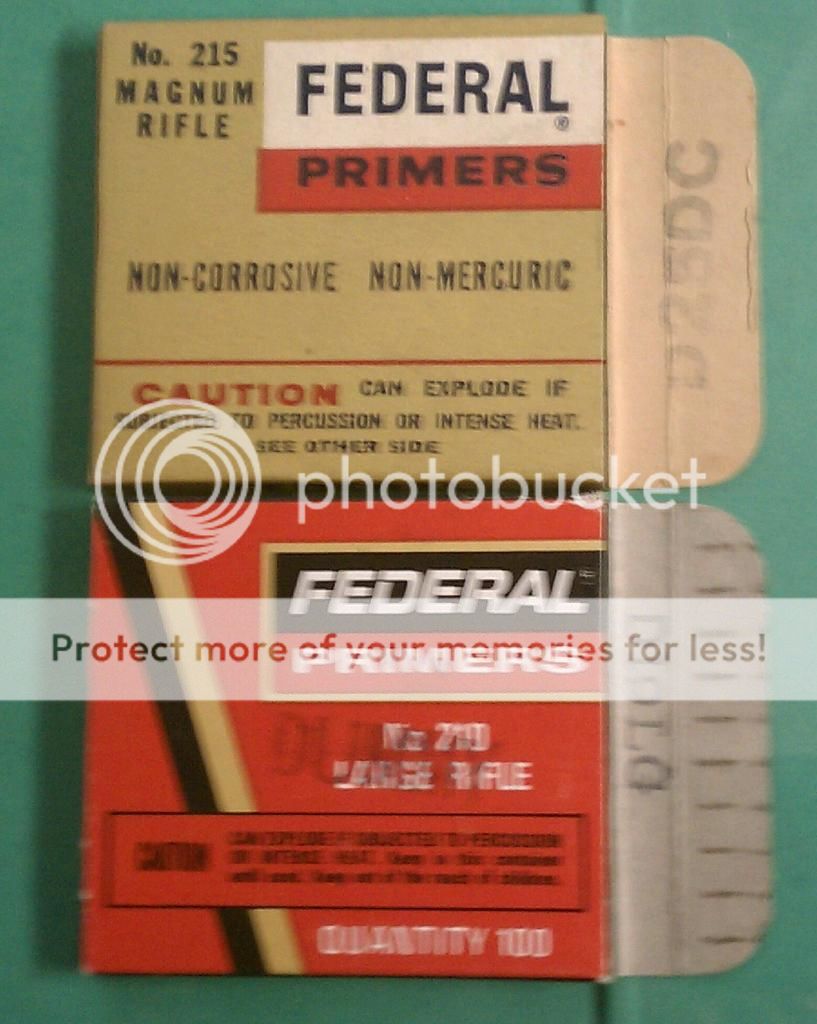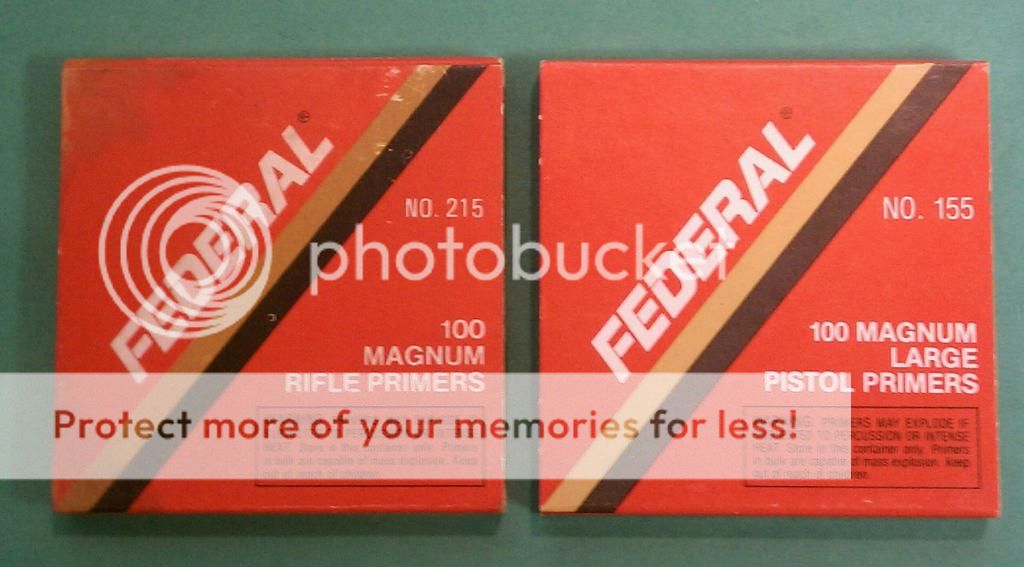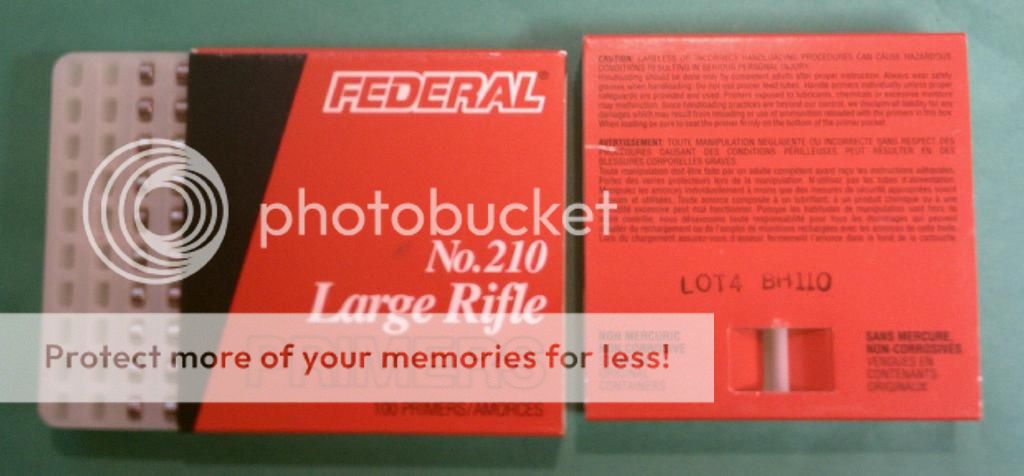You are using an out of date browser. It may not display this or other websites correctly.
You should upgrade or use an alternative browser.
You should upgrade or use an alternative browser.
Dating Federal Cartridge Corporation Primer Boxes
- Thread starter d'Artagnan
- Start date
The #1 community for Gun Owners of the Northeast
Member Benefits:
No ad networks! Discuss all aspects of firearm ownership Discuss anti-gun legislation Buy, sell, and trade in the classified section Chat with Local gun shops, ranges, trainers & other businesses Discover free outdoor shooting areas View up to date on firearm-related events Share photos & video with other members ...and so much more!
Member Benefits:
- Feb 4, 2013
- 28,175
Instead of attaching DOC files, just upload the image files (typically JPEG). That way the pictures show up without having to download and open each DOC file you post.
d'Artagnan
Active Member
OK, I'll give that a try:
Dating Federal Cartridge Corporation Primer Boxes
The Federal Cartridge Corporation started producing commercial center fire ammunition in 1963. Prior to that date, however, Federal was producing primers for reloaders.
I. Early Federal Primer Boxes


The earliest boxes I've encountered are like the upper left in the above photos. The primers are brass, domed, have two-leg anvil, and come in light-colored wooden trays which are a little short for the box and have ten cuts holding 10 primers each. In their lot numbers, A-15-7.21 and A-25.12.4, the first set of numbers are reversed to indicate the last two digits of the year. 15=51 and 25=52. The second set of numbers is the month, and the last numbers are the day the month; 15-7.21 equates to 21 July 1951 and 25.12.4 equates to 4 December 1952.
The next type of boxes are like the upper right and lower left. The large rifle magnum primers (No. 215) are nickel-plated, all others are brass; all are domed, have two-leg anvils, and come in dark-color wooden trays which fit the box. Both compound and anvil are sealed in a transparent red-tinted lacquer. The lot numbers I've observed run from AL-65/19/4 to AL/06/5/10. Like the earlier boxes, the first two digits are reversed to indicate the last two digits of the year. 65=56 and 06=60. The second set of numbers are the day of the month, the last set of number is the month; 65/19/4 is 19 March 1956 and 06/5/10 is 5 October 1960.
Both types of these early boxes all have a strip of cellophane tape on the right side.
With the start of commercial centerfire ammunition production in 1963, Federal changed its primer boxes to the type like the lower right above. They have black plastic trays, as do all subsequent boxes. The box with lot number AL36157 was empty when I acquired it. The first two digits of the lot number, like previous lot numbers, is the last two digits of the year reversed; 36=63. Like those in later lot numbers, I believe the next digits represent the Julian day of the year. Julian day 1 is 1 January , Julian day 32 is 1 February, 31 December is Julian day 365, or 366 in a leap year. 36157 equates to the 157th Julian day (6 June) of 1963. This style box was pictured in Federal's first center fire sporting ammunition catalog in 1963.

The lower 1963-style box, above, has a lot number beginning with BL followed by 56. The 56 I believe equates to 1965. The primers in these boxes are nickel-plated, flat, and have three-leg anvils, like all subsequent Federal rifle and pistol reloading primers with only one exception I know of.

During production packaged in the 1963-style box, the lot numbers changed from AL- and BL-prefix to S-prefix (above) and, finally, to D-prefix (below).

At some point after 1965, the 1963-style primer box was replaced by the black and gold banner red box, which was the same color scheme on contemporary ammuntion boxes. The D-prefix lot numbers also transitioned to the newer boxes. The primers in the lower box with DUMMY overstamp are blackened and are the single exception I know of to all post 1965 Federal rifle and pistol primers for reloaders being nickel-plated.

By 1975 the D-prefix lot numbers (upper) were superceeded by the format still in use today (lower). The S- and D-prefix lot numbers remain unequated by me, but are not in a format used by other U.S. primer manufactures. Indeed, they were used during the height of the Viet Nam War while the Federal Cartridge Corporation operated the Twins Cities Arsenal. When Federal Cartridge started center fire ammunition production in 1963, they were using cartridge cases such as 303 British, 7mm and 8mm Mauser, made in Canada. I wonder if these 1965 to 1974 S- and D-prefix primers were, in fact, also made in Canada. Unfortunately, I've no contemporary Canadian primers to compare them with.
Federal commercial ammunition boxes also bore D-prefix lot numbers.

In the above photo, the Montgomery Ward's Hawthorne-brand 30-30 Winchester box bears the D-prefix lot number BD12AC, and holds FC-headstamped cartridges. The Federal black and gold banner 303 British ammo box (lower) bears the D-prefix lot number AD 20LF. Like primer boxes, the lot numbers on later black and gold banner ammunition boxes were in the format still used today and those date from early 1975.


From 1976 to 1991, a second type of black and gold banner red box was used for primers. At the same time, ammunition used a similar color scheme red box with white and gold banner. Trays are black plastic with individual pockets for each primer to lay flat in. The last 3 digits of the lot number equate to the Julian day of manufacture and the digit before them is the year:
1974 4+Julian day 1984 4+(Julian day + 400)
1975 5+Julian day 1985 5+(Julian day + 400)
1976 6+Julian day 1986 6+(Julian day + 400)
1977 7+Julian day 1987 7+(Julian day + 400)
1978 8+Julian day 1988 8+(Julian day + 400)
1979 9+Julian day 1989 9+(Julian day + 400)
1980 0+Julian day 1990 0+(Julian day + 400)
1981 1+Julian day 1991 1+(Julian day + 400)
1982 2+Julian day 1992 2+(Julian day + 400)
1983 3+Julian day 1993 3+(Julian day + 400)
In the above examples, the lot number ending in 9051 equates to the 51st day (20 February) of 1979 and 6700 equates to the 300th day (700 minus 400, 28 October) of 1976, a leap year.
By 1994 Federal again changed its primer packaging to that below. The trays were now opaque white plastic with individual pockets for the primers in lay in on their sides. In the lot numbers, prior to the three-digit Julian day a letter was used for the year:

In the above lot number, H110 equates to the 110th day (20 April) of 1994. My few examples are from 1994 and 1995.
1994 H+Julian day 2004 H+(Julian day + 400)
1995 Y+Julian day 2005 Y+(Julian day + 400)
1996 R+Julian day 2006 R+(Julian day + 400)
1997 V+Julian day 2007 V+(Julian day + 400)
1998 W+Julian day 2008 W+(Julian day + 400)
1999 Z+Jukian day 2009 Z+(Julian day + 400)
2000 X+Julian day 2010 X+(Julian day + 400)
2001 T+Julian day 2011 T+(Julian day + 400)
2002 N+Julian day 2012 N+(Julian day + 400)
2003 J+Julian day 2013 J+(Julian day + 400)

The most recent style of Federal primer packaging, which I have precisely one type. In its lot number 21X632, the X632 equates to 232nd day (632 minus 400, 20 August) of 2010.
Dating Federal Cartridge Corporation Primer Boxes
The Federal Cartridge Corporation started producing commercial center fire ammunition in 1963. Prior to that date, however, Federal was producing primers for reloaders.
I. Early Federal Primer Boxes


The earliest boxes I've encountered are like the upper left in the above photos. The primers are brass, domed, have two-leg anvil, and come in light-colored wooden trays which are a little short for the box and have ten cuts holding 10 primers each. In their lot numbers, A-15-7.21 and A-25.12.4, the first set of numbers are reversed to indicate the last two digits of the year. 15=51 and 25=52. The second set of numbers is the month, and the last numbers are the day the month; 15-7.21 equates to 21 July 1951 and 25.12.4 equates to 4 December 1952.
The next type of boxes are like the upper right and lower left. The large rifle magnum primers (No. 215) are nickel-plated, all others are brass; all are domed, have two-leg anvils, and come in dark-color wooden trays which fit the box. Both compound and anvil are sealed in a transparent red-tinted lacquer. The lot numbers I've observed run from AL-65/19/4 to AL/06/5/10. Like the earlier boxes, the first two digits are reversed to indicate the last two digits of the year. 65=56 and 06=60. The second set of numbers are the day of the month, the last set of number is the month; 65/19/4 is 19 March 1956 and 06/5/10 is 5 October 1960.
Both types of these early boxes all have a strip of cellophane tape on the right side.
With the start of commercial centerfire ammunition production in 1963, Federal changed its primer boxes to the type like the lower right above. They have black plastic trays, as do all subsequent boxes. The box with lot number AL36157 was empty when I acquired it. The first two digits of the lot number, like previous lot numbers, is the last two digits of the year reversed; 36=63. Like those in later lot numbers, I believe the next digits represent the Julian day of the year. Julian day 1 is 1 January , Julian day 32 is 1 February, 31 December is Julian day 365, or 366 in a leap year. 36157 equates to the 157th Julian day (6 June) of 1963. This style box was pictured in Federal's first center fire sporting ammunition catalog in 1963.

The lower 1963-style box, above, has a lot number beginning with BL followed by 56. The 56 I believe equates to 1965. The primers in these boxes are nickel-plated, flat, and have three-leg anvils, like all subsequent Federal rifle and pistol reloading primers with only one exception I know of.

During production packaged in the 1963-style box, the lot numbers changed from AL- and BL-prefix to S-prefix (above) and, finally, to D-prefix (below).

At some point after 1965, the 1963-style primer box was replaced by the black and gold banner red box, which was the same color scheme on contemporary ammuntion boxes. The D-prefix lot numbers also transitioned to the newer boxes. The primers in the lower box with DUMMY overstamp are blackened and are the single exception I know of to all post 1965 Federal rifle and pistol primers for reloaders being nickel-plated.

By 1975 the D-prefix lot numbers (upper) were superceeded by the format still in use today (lower). The S- and D-prefix lot numbers remain unequated by me, but are not in a format used by other U.S. primer manufactures. Indeed, they were used during the height of the Viet Nam War while the Federal Cartridge Corporation operated the Twins Cities Arsenal. When Federal Cartridge started center fire ammunition production in 1963, they were using cartridge cases such as 303 British, 7mm and 8mm Mauser, made in Canada. I wonder if these 1965 to 1974 S- and D-prefix primers were, in fact, also made in Canada. Unfortunately, I've no contemporary Canadian primers to compare them with.
Federal commercial ammunition boxes also bore D-prefix lot numbers.

In the above photo, the Montgomery Ward's Hawthorne-brand 30-30 Winchester box bears the D-prefix lot number BD12AC, and holds FC-headstamped cartridges. The Federal black and gold banner 303 British ammo box (lower) bears the D-prefix lot number AD 20LF. Like primer boxes, the lot numbers on later black and gold banner ammunition boxes were in the format still used today and those date from early 1975.


From 1976 to 1991, a second type of black and gold banner red box was used for primers. At the same time, ammunition used a similar color scheme red box with white and gold banner. Trays are black plastic with individual pockets for each primer to lay flat in. The last 3 digits of the lot number equate to the Julian day of manufacture and the digit before them is the year:
1974 4+Julian day 1984 4+(Julian day + 400)
1975 5+Julian day 1985 5+(Julian day + 400)
1976 6+Julian day 1986 6+(Julian day + 400)
1977 7+Julian day 1987 7+(Julian day + 400)
1978 8+Julian day 1988 8+(Julian day + 400)
1979 9+Julian day 1989 9+(Julian day + 400)
1980 0+Julian day 1990 0+(Julian day + 400)
1981 1+Julian day 1991 1+(Julian day + 400)
1982 2+Julian day 1992 2+(Julian day + 400)
1983 3+Julian day 1993 3+(Julian day + 400)
In the above examples, the lot number ending in 9051 equates to the 51st day (20 February) of 1979 and 6700 equates to the 300th day (700 minus 400, 28 October) of 1976, a leap year.
By 1994 Federal again changed its primer packaging to that below. The trays were now opaque white plastic with individual pockets for the primers in lay in on their sides. In the lot numbers, prior to the three-digit Julian day a letter was used for the year:

In the above lot number, H110 equates to the 110th day (20 April) of 1994. My few examples are from 1994 and 1995.
1994 H+Julian day 2004 H+(Julian day + 400)
1995 Y+Julian day 2005 Y+(Julian day + 400)
1996 R+Julian day 2006 R+(Julian day + 400)
1997 V+Julian day 2007 V+(Julian day + 400)
1998 W+Julian day 2008 W+(Julian day + 400)
1999 Z+Jukian day 2009 Z+(Julian day + 400)
2000 X+Julian day 2010 X+(Julian day + 400)
2001 T+Julian day 2011 T+(Julian day + 400)
2002 N+Julian day 2012 N+(Julian day + 400)
2003 J+Julian day 2013 J+(Julian day + 400)

The most recent style of Federal primer packaging, which I have precisely one type. In its lot number 21X632, the X632 equates to 232nd day (632 minus 400, 20 August) of 2010.
Users who are viewing this thread
Total: 2 (members: 0, guests: 2)
Forum statistics
Latest threads
-
-
-
-
-
-
-
Looking for used guns, optics, and parts, give us a call!
- Started by SandSGunsSOMD
- Replies: 0

